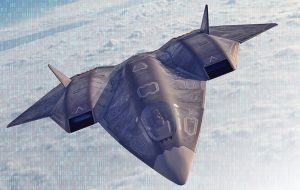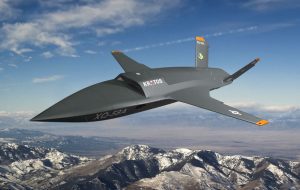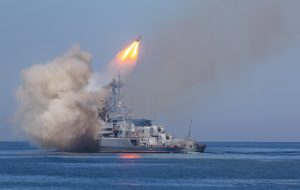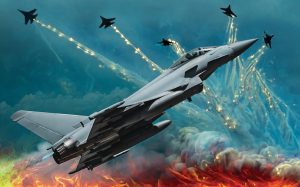In March 2022, the Stockholm International Peace Research Institute (SIPRI), headquartered in Sweden, issued its annual report on global military spending, stating that it amounted to about 1981 billion dollars in 2021, which is equal to 2.4% of the global GDP (a 0.7 % increase compared to 2020). The U.S and China ranked at the top of the list of countries spending the most on armaments, followed by India, Britain, and Russia.
Furthermore, Australia increased its new military budget by about $3.5 billion, to equip combat aircraft and warships with long-range missiles.
The report revealed that in 2021, Russia increased its military spending by 2.9%, while China spent $293 billion on its army (a 4.7% increase compared to 2020), and Japan spent $54.1 billion on its military. For its part, Russia spends about 4.14 % of its GDP on its military, while Britain spends about 2.33 %, according to the SIPRI Institute 2020 data. Nowadays, new rivalries and conflicts among the world’s superpowers are driving the increase in the pace of the global arms race and military spending. While humanity is now facing a set of common challenges that can only be addressed through international cooperation in various fields such as food security, climate change, and energy, relations between these superpowers have deteriorated. Fear of the future and political polarization drives countries to boost their military power to protect their national security, which prompts the major powers around the world to get involved in regional as well as internal conflicts to sell weapons to the warring parties, and given that modern warfare is characterized by the rapid consumption of ammunition in general and missiles in particular, these major powers get to continue selling their weaponry and make a huge profit. The arms trade has an international market that is subject to rules of supply and demand, therefore the persistence of armed conflicts between countries and groups is in the best interest of the arms-exporting countries.
Thus whenever conflicts subside in a region, those exporting countries try to reignite them in different regions, to boost the demand for their weapons. The arms trade is a massive and complex trade, in which interests and profits are mixed with the strategic goals and national policies of the countries that manufacture and export weapons. Weapons have technical, practical, and political aspects, as some countries buy weapons they know they won’t or cannot use or maintain, and these weapons are usually sold with training and use courses and come with preset operational rules.
Therefore it is believed that some countries buy and stockpile weapons as deterrents to others. The increase in defense budgets confuses the national priorities of countries, by taking away funding from social and developmental programs, which leads to postponing many future projects, and with each arms deal made by one country, the sense of danger and insecurity grows in other countries, which in turn fuels their desire to acquire more weapons and make new deals, thereby intensifying the arms race and military spending, spreading more tension and increasing the likelihood for conflict and war.
The nuclear arms race
In light of the global escalation of the nuclear arms race, the Stockholm International Peace Research Institute has predicted the growth of the global nuclear arsenal in the coming years for the first time since the Cold War. The institute also revealed that the Russian-Ukrainian war sparked an escalation of tensions between the countries of the nuclear club.
Furthermore, in its 2022 yearbook, the institute said, “All nuclear-armed countries are increasing or developing their arsenals, and most of them are escalating their nuclear rhetoric along with the role that nuclear weapons play in their military strategies, which is a deeply troubling trend.” Russia controls the largest nuclear arsenal in the world, with a total of 5,977 nuclear warheads, which is about 550 more than the United States. Together the two countries control more than 90% of the world’s nuclear weapons, with an estimated 3,732 of them deployed, and about 2,000 kept on high alert. In 2021, the nuclear powers increased their spending on modernizing their nuclear arsenal, by about 9 %, reaching a total of $82.4 billion, according to a report by the International Campaign to Abolish Nuclear Weapons (ICAN), a non-governmental organization (NGO). The report, issued on June 14, 2022, stated that the U.S spent $44.2 billion on its nuclear program in 2021 (an increase of 12.7 % compared to 2020), while China allocated $11.7 billion (an increase of 10.4 % compared to 2020).
The NGO also reported an increase in budgets for nuclear weapons, amounting to $8.6 billion for Russia, $5.9 billion for France, and $6.8 billion for the UK, while Pakistan allocated $1.1 billion (compared to $1 billion in 2020).
India on the other hand reduced its spending on nuclear weapons from $2.5 billion in 2020 to $2.3 billion in 2021.
The NGO explained that the taxpayers’ money was used to award new contracts to private companies, with a total value of $30.2 billion to modernize the major powers’ nuclear arsenals, and these private companies, hired think tanks and lobby groups to defend the effectiveness of nuclear weapons.
Conventional arms market revival
With many countries seeking to strengthen their military arsenal and the West providing Ukraine with military aid, which included artillery, missiles, armored vehicles, drones, and all kinds of ammunition, the conventional arms market has seen a boom in 2022.
This created a shortage of strategic stocks in the arms depots of those countries, which in turn triggered moves to restock these arsenals, prompting defense companies to increase their production.
U.S based companies were the main beneficiaries of this increase, and on September 9, 2022, the Pentagon announced contracts amounting to $1.2 billion to restock the weapons and ammunition stockpile, after its depletion, of which $352 million were allocated for the purchase of Javelin anti-tank missiles, $624 million for short-range Stinger air defense missiles Stinger and $33 million for Himars launcher systems.
Weapon purchase requests flowed from countries in Eastern Europe, and Poland signed a contract with South Korea to buy 212 howitzers and nearly 400 “K2 Black Panther” tanks, in August 2022.
The K2 Black Panther is equipped with interactive armor, an active counter protection system, a German 120 mm cannon, and a fire control system capable of monitoring, tracking, and firing automatically on ground targets and verticals flying at low altitudes.
Signed in July 2022, the contract states that the 180 tanks be delivered by 2025, along with training, logistics, and ammunition operations.
On August 25, 2022, the U.S officially announced the sale of 250 M1A2 SEPv3 Abrams tanks to Poland, as part of a larger deal valued at $1015 billion, with delivery starting in January 2025.
This tank is characterized by several advantages in communications, firepower, fuel efficiency, and self-protection.
Furthermore, the aforementioned deal is part of a larger $6 billion deal between Poland and the U.S, which includes anti-IEDs devices, machine guns, logistical rescue vehicles, and storming bridges.
On August 27, 2022, Slovakia (a member of NATO) announced that neighboring Poland and the Czech Republic would protect its airspace, as it replaces its Russian-made MiG-29 fighters with the American F-16 in 2024, due to the rising costs of maintaining the Russian fighters, in addition to the fact that Russian technicians are leaving gradually.
On September 9, 2022, Turkey announced that it may buy combat aircraft from countries such as Britain, France, and Russia if it failed to get the F-16 fighters from the U.S.
For its part, Washington has refrained from delivering Turkey the F-35 fighters under the pretext of Ankara’s procurement of the Russian S-400 air defense system instead of the American Patriot defense system it was denied.
Furthermore, Turkey had submitted a request to the U.S to purchase 40 F-16 fighters as well as equipment to modernize 80 of its warplanes.
During the Russian Army Forum in August 2022, the Russian Defense Ministry announced that it signed contracts worth $16.3 billion with foreign customers for the supply of Mi-38 helicopters, Su-30SME fighters, and Pantsir-S1M air defense systems.
The European Commission announced the allocation of a 500 million euros budget to be spent by 2024 to partially finance joint military purchases, such as light and heavy missiles, anti-aircraft systems, and other European-made weaponry, compared to allocating only 11 % of military spending to joint European investments in 2021 down from 35% in 2017.
Furthermore, at the end of June 2021, the Swiss government decided to purchase 36 American F-35A aircraft worth 5.6 billion euros, despite the competition from the French “Rafale” and the European Eurofighter Typhoon.
The F-35 fighter program is a partnership of eight countries, and fighters that will be delivered to Switzerland will be assembled in Italy.
On August 16, 2022, the German chancellor said in his speech to officers in the German army in Berlin that Germany should become the best-equipped armed force in Europe, because of its superior numbers and economic power, and its central location in the continent.
He called for increasing the European influence in NATO and announced the allocation of 100 billion euros to a special fund for the military, and raised defense spending above the minimum (2% of GDP) commitment of the alliance countries. Since the end of the Cold War, Germany has reduced the size of its armed forces from around 500,000 in 1990 to 200,000 today.
Furthermore, Germany is planning to buy the F-35 fighters to replace the old Tornado jets that have been in service in the German Air Force since the 1980s (the only German aircraft capable of carrying the US nuclear bombs stored in Germany). In addition, Germany said it is planning to buy 60 Chinook transport helicopters and on September 12, 2022, it was announced that Germany is negotiating with Israel to purchase the ARROW-3 air defense system, an anti-ballistic missile defense system developed by Israel and the U.S to intercept ballistic missiles outside the Earth’s atmosphere. On August 26, 2022, Belarus announced it had completed the retrofit of its nuclear-capable military aircraft, including modifying the Su-24 aircraft to enable it to carry nuclear weapons, based on a previous agreement with Moscow.
While Belarus does not have nuclear weapons, Moscow will provide it with mobile missile systems, the Eskandar-M model, which can carry conventional or nuclear warheads.
On September 21, 2022, the British Prime Minister confirmed in her speech to the United Nations General Assembly, that the U.K is pledging to allocate 3% of its GDP for defense by 2030, which represents a significant increase compared to the minimum spending of 2 % required by NATO.
Anxiety in Japan and Taiwan
The Japanese people’s interest in national security and the need to strengthen defense capabilities has increased dramatically, prompting an increase in defense spending to 2% of GDP. On August 29, 2022, the Japanese Ministry of Defense issued a budget request for the fiscal year 2023, seeking the allocation of $40 billion for defense spending, which is an unprecedented amount, in addition to unspecified sums of money for the procurement of several systems, including the early deployment of long-range missiles, and anti-ship missiles with a range of about 1,000 km (a 100 km increase from current systems).
These new missiles can attack land targets and the ministry plans to develop drones that can be used for surveillance and intelligence gathering as well as attack. Furthermore, Japan will build ships equipped with an anti-ballistic missile system that can intercept ballistic and hypersonic missiles.
So far Japan’s Self-Defense Forces’ arms purchases remain limited to defense, thus they avoided buying weapons that could be considered offensive.Japan’s Maritime Self-Defense Force is considered one of the world’s most efficient navies in the fields of anti-submarine warfare and mine clearance and it plans to build two new ships equipped with the Aegis anti-ballistic missile defense system.
On September 2, 2022, the U.S State Department announced 3 contracts worth $1.1 billion for arms sales and technical services to Taiwan, noting that the first contract is worth $665.4 million and is allocated to providing equipment and logistical support for Taiwan’s radar stations.
The second contract worth $335 million will provide 60 AGM-84L Harpoon Block II anti-ship missiles and 4 ATM-84L-1 Harpoon Block II missiles, while the third contract worth $85.6 million will provide 100 AIM-9X Block II Sidewinder tactical air-to-air missiles.
The AUKUS deal
In June 2022, Australia announced a settlement of $585 million to compensate France for canceling scrapping a submarine deal worth 35 billion euros, when a French company was contracted to build a fleet of submarines before Australia replaced the French deal with another with the U.S and the U.K. for nuclear-powered submarines, Which was known as the “Aukus” deal (a security pact between Australia, the U.K, and the U.S to confront security challenges in the Indian and Pacific Oceans.
The agreement includes the exchange of information and technologies in various fields such as intelligence and providing Australia with “Tomahawk” cruise missiles.
Nuclear submarines are more efficient than conventional submarines, and they are more difficult to detect and track, these submarines will be powered by nuclear reactors, but will not be armed with nuclear weapons.
The security pact demonstrates the willingness of the U.S and Britain to take the important step of exporting nuclear technology to a non-nuclear country, which Washington has only done once in 1958 when it supplied Britain with that technology. In addition, the move shows the seriousness of both the U.S and Britain in engaging in strategic competition in the Pacific and Indian oceans, which indicates a desire to expand the Five Eyes (FVEY), an arrangement for sharing intelligence information between five English-speaking countries: the U.S, Britain, Canada, Australia, and New Zealand.
The Five Eyes alliance was developed during the Cold War to include sharing advanced military industry and technologies, and it seems in line with the US administration’s pledge to prioritize strategic competition with China, in addition to boosting Washington’s traditional alliances, including the “Quad” (Australia, Japan, India, and the United States).
As a part of the security pact, Australia gets the technology to build 8 nuclear-powered submarines from the United States and Britain, to counter China’s influence in the disputed South China Sea. Furthermore, the pact covers access to artificial intelligence and other technologies, making it one of the largest defense partnerships between the three countries in decades, meaning that Australia will become the seventh country in the world to possess nuclear-powered submarines, after the U.S, Russia, Britain, France, China, and India.
The black market arms trade
Discussions regarding the black market arms trade revolve around the hundreds of thousands of shoulder-mounted air defense system missiles produced in the past few decades, and these easily obtained and relatively cheap black market missiles have been used in many conflicts against military and civilian targets and On February 24, 2005, Moscow and Washington signed an agreement to restrict the proliferation of these missiles.
However, there are shady and highly complex global networks of arms producers, procurement agents, brokers, banks, and shipping companies that are adept at evading UN sanctions and carrying out untraceable operations.
This is known as illegal arms trafficking, which often includes the purchase and sale of weapons with the knowledge of some governments.
However, the problem lies in some countries’ adherence to the sanctions issued by the UN Security Council, while other countries don’t firmly adhere to the rules and regulations or just disregard them completely.
For their part, Private military companies which carry out military missions on behalf of governments or opposition forces, play a crucial role in supplying weaponry and supporting all kinds of regimes around the world, as such companies enjoy an advantage in the business of importing arms, given their connections to governments, arms brokers, air freight companies, and arms manufacturers.
The ethical aspect of the arms trade
Some arms-exporting countries violate many of the treaties and agreements they approve regarding the arms trade, the most important of which is that it is not permissible to approve any arms deal that would result in the use of offensive weapons against ethnic or religious groups, or others, outside international law.
Some countries had announced their adoption of a foreign policy with an ethical aspect, meaning subjecting foreign policy to moral controls, such as observing human rights, and not cooperating with specific countries in the fields of arms export and others, however in reality these countries bypass all of these policies and some countries are involved in supplying arms to parties involved in bloody conflicts.
Field of competition
The diversity of security challenges has always been a key part of arms diversity, the varying nature of weaponry and their purpose, thus it was only natural for the arms markets to diversify their products starting with individual weapons, up to the latest types of aircraft, missiles, armored vehicles, and electronic warfare methods.
Even though major countries had monopolized the advanced and heavy weapons export market, they did not neglect the individual small arms market, such as pistols, rifles, machine guns, mines, and hand grenades.
The arms industry and trade have become a highly coveted field of competition between industrialized countries, which compete to make the most tempting arms deals, thereby increasing arms exhibitions, where the most advanced and the easiest to use products are displayed, as if it was a matter of community development that had nothing to do with killing, destruction, and financial depletion.
Arms exporting countries impose restrictions on their exports to maintain some control and while the arms trade, like other types of trade, is subject to market demand and competition, this competition factors in the political and military situation of the buyer, whether it was a state, an organization, or a militia.
One of the key factors in this field is the nature of the conflict the arms are likely to be used in, and the weapons and combat techniques that the opposing party possesses, to test these weapons in real warfare and within the framework of weapons and countermeasures, such as the possibility of operating tanks and anti-tank missiles, turning wars into fields for testing weapons, technology, and operational management.
» By: Major General Dr. Ali Muhammad Ali Rajab
(military researcher and strategic expert)













